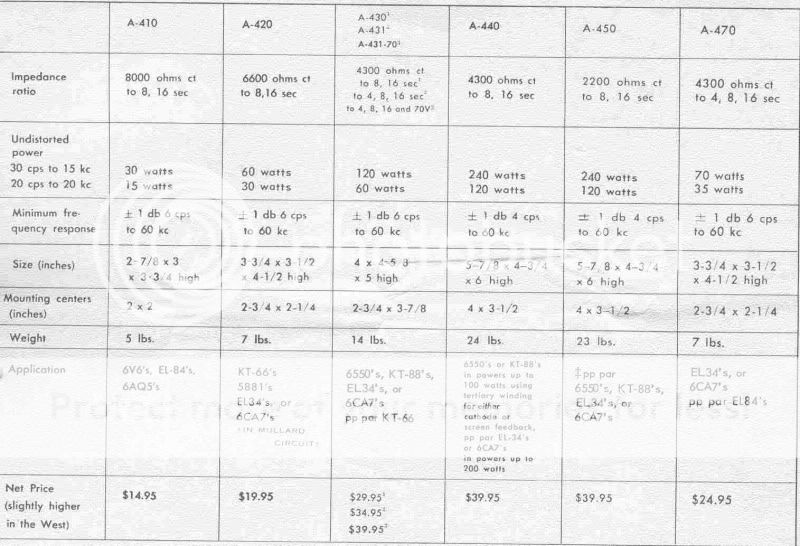Hi,
I'm looking at an EL34 Chinese amp. They list a few specs about the output transformers and I was wondering if these sound like decent quality trannys?
I'm looking at an EL34 Chinese amp. They list a few specs about the output transformers and I was wondering if these sound like decent quality trannys?
The transformers adopt high silicon steel orientation sheets with minimum magnetic induction intensity--1.9T and coupled with special primary secondary winding construction, its technical index proves that it has broken through old standard of output transformer.
Its primary impedance is 5KO,primary inductance is 234H(50Hz), primary leaking inductance is 2.27mH(1KHz-10KHz), primary distributed capacitance is 85P ,frequency response is 5Hz-342KHz(-3db 5V) and primary rising impedance is =56O(1KHz-10KHZ).(Note: the above tested by voltage comparison method)
Well...
I see a number of problems here...
19,000 Gauss would be the Bsat of the material they are using....
I certainly hope they would not operate the steel at that Flux density, since the harmonics from core distortion would be disasterous....
They are probably pushing 13000 Gauss...
As for inductance being a fixed number...not so.... It varies greatly with applied AC signal.... Capacitance increases with signal level and fequency...in 99% of cases...
The leakage would be the only number that would be a true fixed constant...
They also left out the primary to secondary capacitance....
As for -3dB@342kHz .... I believe they goofed the math....
I measure the parameters on the bench with the same applied AC signal that it would see at full power output for that given plate load.... then you get some real world numbers.... Testing at 5V as indicating is cheating to show a better high frequency bandwidth, but a worse low fequency extension....
Don't add up....
cerrem
I see a number of problems here...
19,000 Gauss would be the Bsat of the material they are using....
I certainly hope they would not operate the steel at that Flux density, since the harmonics from core distortion would be disasterous....
They are probably pushing 13000 Gauss...
As for inductance being a fixed number...not so.... It varies greatly with applied AC signal.... Capacitance increases with signal level and fequency...in 99% of cases...
The leakage would be the only number that would be a true fixed constant...
They also left out the primary to secondary capacitance....
As for -3dB@342kHz .... I believe they goofed the math....
I measure the parameters on the bench with the same applied AC signal that it would see at full power output for that given plate load.... then you get some real world numbers.... Testing at 5V as indicating is cheating to show a better high frequency bandwidth, but a worse low fequency extension....
Don't add up....
cerrem
Ok, well this is all new to me so any help is much appreciated.
From what I've read online, the "1.9 T" would be the flux density that the lamination material (I asssume it's M6 GOSS) saturates at, is that right? I understand that to be a pretty good figure and would indicate decent low frequency performance, no? Would this also indicate the hysteresis loop would be fairly linear?
From what I've read online, the "1.9 T" would be the flux density that the lamination material (I asssume it's M6 GOSS) saturates at, is that right? I understand that to be a pretty good figure and would indicate decent low frequency performance, no? Would this also indicate the hysteresis loop would be fairly linear?
There is not a precise value of induction that cause lamination material to saturate.
Indeed, losses and unlinearity increase with induction and anyone is free to use any value wich fits its needs.
For exemple, a transformer designed to power a microwave oven which will run say, 15 minutes twice a day may push its lams at more than 2 tesla without problem.
For an OPT using GOSS M6X lams, I beleive that 1.4 tesla is the limit that can be tolerated in the worst situation, that is when the maximum power and the lowest frequency occur simultaneously and continuously.
Above, the laminations not only introduce their own distortion but, because the inductance falls down, the tubes are no longer properly loaded and distord themselves.
Yves.
Indeed, losses and unlinearity increase with induction and anyone is free to use any value wich fits its needs.
For exemple, a transformer designed to power a microwave oven which will run say, 15 minutes twice a day may push its lams at more than 2 tesla without problem.
For an OPT using GOSS M6X lams, I beleive that 1.4 tesla is the limit that can be tolerated in the worst situation, that is when the maximum power and the lowest frequency occur simultaneously and continuously.
Above, the laminations not only introduce their own distortion but, because the inductance falls down, the tubes are no longer properly loaded and distord themselves.
Yves.
- Status
- This old topic is closed. If you want to reopen this topic, contact a moderator using the "Report Post" button.
- Home
- Amplifiers
- Tubes / Valves
- OPT specs
